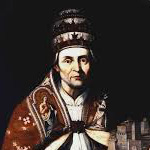
After living most of his life in seclusion, Pope Celestine V was elected pope at the age of 79. After only five months, he resigned from the papacy with the hope of returning to his life as a hermit. Celestine V is one of only a few popes to give up the title voluntarily.
Early Life
Pietro – the boy who would become Pope Celestine V – had to work in the fields as a child after his peasant father died. At age 17, he became a monk in the Benedictine order, and eventually, he was ordained a priest. He preferred to spend most of his time in the wilderness fasting and praying.
The Holy Monk
Pietro’s devotion attracted several followers. While he desired solitude, the followers wanted to be with him so they could learn his ways. To help his followers, Pietro formed a new religious community that eventually took the name Celestines after his papal name. The order grew to thirty-six monasteries and more than 600 monks while Pietro led the group. Not one to seek power, Pietro handed off the leadership of the order so he could return to his solitary life.
Election to Pope
For twenty-seven months after Pope Nicholas IV died, no Pope elected because the College of Cardinals could not agree on his successor. There were political reasons why the cardinals could not decide on any of the candidates. None of the cardinals were willing to elect a candidate that would give the other side more power.
The legend goes that one cardinal made the statement that the holy hermit Pietro del Morrone made a prophecy that a disaster would happen to the cardinals if a pope were not elected soon. To the surprise of many, the cardinals then elected Pietro unanimously. The fact that Pietro was not interested in politics or power made him the one person all of the cardinals could agree upon.
Pope Celestine V
From the very beginning, Pietro was reluctant to be the pope. At first, he refused the position. Eventually, Pietro was persuaded by the cardinals and the king of Naples. Given his advanced age of 79 and his lack of political experience, he ended up being a weak and ineffective leader. The king of Naples controlled most of the decisions Celestine made.
Realizing his weaknesses as a leader, Celestine consulted with the cardinal who would eventually succeed him as Pope Boniface VIII. Under Boniface’s direction and his desire to give up his title, Celestine made his final decree which was a declaration for the right of resignation. He then promptly exercised that right and resigned after serving as pope for only 161 days.
After His Papacy
Celestine planned to return to his life in the wilderness as a simple monk, but that would not be. Concerned that his enemies might use Celestine as someone to question his authority, Pope Boniface VIII had Celestine imprisoned in a castle. After only ten months of imprisonment, Celestine died. Rumors started spreading that Boniface had Celestine executed.
After Boniface died, some of Celestine’s supporters nominated him for sainthood. In 1313, Celestine was canonized a saint.
Quick Facts About Pope Celestine V
- Born in 1215 in Sicily to a peasant family.
- Named Pietro Angelerio at birth, he was often called Pietro del Morrone.
- Founded the monastic order later known as the Celestines after his papal name.
- Served as Pope of only five months before his surprise resignation.
- Died while imprisoned on orders of his successor.
- Canonized in 1313 by Pope Clement V.
- Succeeded by Pope Boniface VIII
Interesting Facts About Pope
- Pietro del Morrone translates to Peter of Mount Morrone – the name of a mountain where Pietro lived as a hermit.
- Pietro modeled his life after John the Baptist. He preferred to live in the wilds and fast every day.
- Celestine V was the pope who formalized the resignation process for a Pope. While his resignation was a surprise to many, it appears Celestine had his own resignation in mind.
- His remains survived a major earthquake in 2009. Some attribute this as another miracle by the saint.